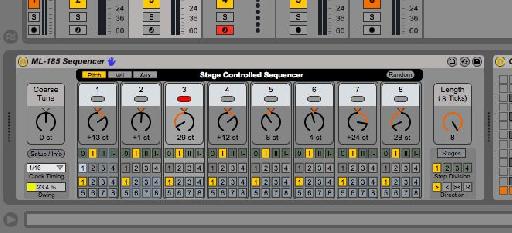We live in a crazy techno world: Max for Live – now included with Live 9 Suite – has opened a Pandora's box of user-generated audio effects, instruments, MIDI devices, and utilities. In this ongoing feature, we'll explore some of the best Max for Live devices to emerge from the ever-expanding open-source M4L developer community.
Two areas in which Max for Live excels are generative MIDI devices and emulations of classic hardware. Today we'll take a look at the ML-185 Step Sequencer, developed by 3st and downloadable for free here:
http://www.maxforlive.com/library/device.php?id=75
It's a randomize-able 8-step sequencer modelled after the M-185 sequencer developed for the Roland System 100m modular synthesizer. Since it's a MIDI effect, you can route the signal through whatever sort of instrument sound you want to use in the end – but if you're ever wondering how many of the classic Detroit “bleep” techno records were created, look no further.
Sequential Triad
You'll notice three main sequencing parameters: Pitch, Velocity, and Auxiliary – which can be assigned to any MIDI CC value via the pop-up access by clicking the Setup/Info button. Each of the eight steps can be sequenced by adjusting the corresponding dial for each step – or, for quick idea generation, just hit the “Random” button to randomize the values for the selected editing parameter.
Randomized pitch in and of itself isn't going to yield particularly musical results, but you'll notice in the picture below that I've followed the ML-185 with a MIDI Scale device, and I suggest you try the same: find a scale that works for you, place it after the sequencer, and all randomized pitches will now conform to your selected scale. Either way, you can randomize your sequences wholesale and additionally fine-tune the pitch of specific steps as needed.
PRO-TIP: Play with inserting a Chord MIDI Effect before or after the Scale device for added harmonic content with polyphonic instruments.
Every Step Is Special
Each of the eight steps has a number of timing options, in the three numeric fields located below each step's parameter dial. With the default “I” selected in the top Stage row, each step will play once; in this mode, the bottom two rows specify how many sixteenth notes each step is held for – so switching it, for example, to “4”, will hold that step for a quarter note.
Switching the top row to “0”, the step becomes a rest, the duration of which is again set by the bottom two rows. Setting the top row to “II” repeats the note at clock timing intervals set by the now-active Step Division row (second from the top), for the duration set by the bottom two rows; for example: if a step is set to this mode, with the second row set to 2 and the bottom row set to 8, that step will repeat every two sixteenth notes for a duration of eight sixteenth notes before moving to the next step in the sequence. The rhythmic permutations available through this functionality are expansive indeed.
Global Transformations
On the left side of the unit, we have a Coarse Tune dial to pitch our entire sequence up or down with one easy motion; below this, we have the overall clock timing – which can also be set to eighth or thirty-second notes – and beneath that, a sixteenth-note-based classic swing control.
Over on the far right, we have a sequence Length control, which allows for rapidly shortening the sequence – which can be done to simply achieve a more hypnotic pattern, or manipulated intermittently on the fly to intensify the sequence repetition. Clicking the Stages button to enter Fixed mode allows us to change the repeating Step Division for all steps simultaneously, rather than each discretely.
Finally, at the bottom right, we have our sequence playback direction selector, which allows for four modes that can be selected on the fly: our default forward playback going through our steps left to right, reverse playback order through our sequence from right to left, cyclic forward-reverse mode which effectively doubles our sequence length as it goes left to right then right to left, and random, which plays our available steps back in a randomized order.
PRO-TIP: While there's no shortage of musical patterns ready to emanate from this device, it can be difficult to store or recall them. You'll notice I've configured a MIDI Capture track in my set to receive MIDI input from the sequencer track, so I can record my ML-185 generated sequences to actual MIDI clips for future use – a handy trick for quickly generating new material.
Infinite Sequencing
As you can see, just one Max for Live device can open up wide horizons of possibility. So what are you waiting for? Grab ML-185 for free and start tweaking!
The Best Max For Live Devices in Live 9, Part 2
The Best Max for Live Devices, Part 3
The Best Max For Live Devices, Part 4: Four More Cool Devices




 © 2024 Ask.Audio
A NonLinear Educating Company
© 2024 Ask.Audio
A NonLinear Educating Company
Discussion
Want to join the discussion?
Create an account or login to get started!